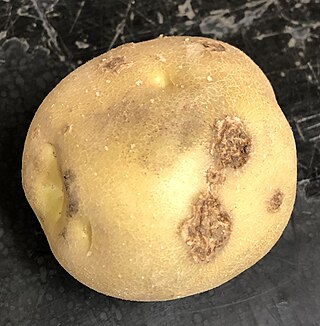
The Actinomycetota are a diverse phylum of Gram-positive bacteria with high G+C content. They can be terrestrial or aquatic. They are of great economic importance to humans because agriculture and forests depend on their contributions to soil systems. In soil they help to decompose the organic matter of dead organisms so the molecules can be taken up anew by plants. While this role is also played by fungi, Actinomycetota are much smaller and likely do not occupy the same ecological niche. In this role the colonies often grow extensive mycelia, like a fungus would, and the name of an important order of the phylum, Actinomycetales, reflects that they were long believed to be fungi. Some soil actinomycetota live symbiotically with the plants whose roots pervade the soil, fixing nitrogen for the plants in exchange for access to some of the plant's saccharides. Other species, such as many members of the genus Mycobacterium, are important pathogens.

Streptomyces is the largest genus of Actinomycetota, and the type genus of the family Streptomycetaceae. Over 700 species of Streptomyces bacteria have been described. As with the other Actinomycetota, streptomycetes are gram-positive, and have very large genomes with high GC content. Found predominantly in soil and decaying vegetation, most streptomycetes produce spores, and are noted for their distinct "earthy" odor that results from production of a volatile metabolite, geosmin. Different strains of the same species may colonize very diverse environments.

Glufosinate is a naturally occurring broad-spectrum herbicide produced by several species of Streptomyces soil bacteria. Glufosinate is a non-selective, contact herbicide, with some systemic action. Plants may also metabolize bialaphos and phosalacine, other naturally occurring herbicides, directly into glufosinate. The compound irreversibly inhibits glutamine synthetase, an enzyme necessary for the production of glutamine and for ammonia detoxification, giving it antibacterial, antifungal and herbicidal properties. Application of glufosinate to plants leads to reduced glutamine and elevated ammonia levels in tissues, halting photosynthesis and resulting in plant death.
Streptomyces venezuelae is a species of soil-dwelling Gram-positive bacterium of the genus Streptomyces. S. venezuelae is filamentous. In its spore-bearing stage, hyphae perfuse both above ground as aerial hyphae and in the soil substrate. Chloramphenicol, the first antibiotic to be manufactured synthetically on a large scale, was originally derived from S. venezuelae. Other secondary metabolites produced by S. venezuelae include jadomycin and pikromycin.

Streptomyces griseus is a species of bacteria in the genus Streptomyces commonly found in soil. A few strains have been also reported from deep-sea sediments. It is a Gram-positive bacterium with high GC content. Along with most other streptomycetes, S. griseus strains are well known producers of antibiotics and other such commercially significant secondary metabolites. These strains are known to be producers of 32 different structural types of bioactive compounds. Streptomycin, the first antibiotic ever reported from a bacterium, comes from strains of S. griseus. Recently, the whole genome sequence of one of its strains had been completed.

Streptomyces hygroscopicus is a bacterial species in the genus Streptomyces. It was first described by Hans Laurits Jensen in 1931.

Common scab is a plant disease of root and tuber crops caused by a small number of Streptomyces species, specifically S. scabies, S. acidiscabies, S. turgidiscabies and others. Common scab mainly affects potato, but can also cause disease on radish, parsnip, beet, and carrot. This plant disease is found wherever these vegetables are grown.

Streptomyces antibioticus is a gram-positive bacterium discovered in 1941 by Nobel-prize-winner Selman Waksman and H. Boyd Woodruff. Its name is derived from the Greek "strepto-" meaning "twisted", alluding to this genus' chain-like spore production, and "antibioticus", referring to this species' extensive antibiotic production. Upon its first characterization, it was noted that S. antibioticus produces a distinct soil odor.
Streptomyces graminisoli is a bacterium species from the genus of Streptomyces which has been isolated together with Streptomyces rhizophilus from rhizosphere soil from the plant Sasa borealis.
Streptomyces guanduensis is an acidophilic bacterium species from the genus of Streptomyces which has been isolated from pine forest soil from Guandu in the Yunnan Province in China.
Streptomyces lilacinus is a bacterium species from the genus of Streptomyces which has been from soil.
Streptomyces longisporus is a bacterium species from the genus of Streptomyces which has been isolated from soil.
Streptomyces paucisporeus is a bacterium species from the genus of Streptomyces which has been isolated from acidic soil from the Yunnan Province in China.
Streptomyces rhizophilus is a bacterium species from the genus of Streptomyces which has been isolated from rhizosphere soil from the plant Sasa borealis.
Streptomyces rubidus is an acidophilic bacterium species from the genus of Streptomyces which has been isolated from soil from a pine forest in Yanglin in the Yunnan province in China.
Streptomyces thermogriseus is a thermophilic bacterium species from the genus of Streptomyces which has been isolated from a hot spring in Eryuan in the Yunnan Province in China.
Streptomyces yanglinensis is an acidophilic bacterium species from the genus of Streptomyces which has been isolated from soil from a pine forest in Yanglin in the Yunnan province in China.
Streptomyces adustus is a bacterium species from the genus of Streptomyces which has been isolated from bamboo forest soil in Damyang on Korea.
Streptomyces broussonetiae is a bacterium species from the genus of Streptomyces which has been isolated from rhizospheric soil of the plant Broussonetia papyrifera.
Streptomyces lasalocidi is a bacterium species from the genus of Streptomyces which has been isolated from soil from the Hyde Park in Massachusetts.






